
|
|
| www.wildfirenews.com | Archived 03-18-2003 |
|
NATIONAL FIRE TEAMS MAY BE ON INCREASED ALERTMARCH 18 -- BOISE, IDAHO: FEMA announced yesterday that the Department of Homeland Security (DHS) raised the national threat level from an Elevated to a High risk of terrorist attack -- Level Orange -- and the 16 Type 1 incident management teams may go to an elevated level of on-call status if the level is upgraded from orange to red.
The Bush administration asked state governors last night to deploy National Guard troops or state police to protect government buildings, bridges, memorials, reservoirs and other public sites, and according to a New York Times report, the DHS will order the detention of all immigrants seeking political asylum in the United States if they arrive here from any one of 34 countries where al-Qaeda and other terrorist groups are known to have operated. The FBI will expand surveillance of Iraqi immigrants in the United States, and will request interviews with more than 10,000 of the nearly 131,000 Iraqi immigrants who have entered the nation since the 1991 war in the Persian Gulf. The Bush administration made its request for the deployment of the National Guard and state police in a telephone conference call to governors about 30 minutes before Bush issued his televised ultimatum last night to Saddam Hussein. New security precautions will go beyond those imposed last month when the government raised the alert level to "high" for 20 days. The 16 national incident management teams' rotation schedule may see a deployment boost if the DHS raises the threat level to red. At the red level, two teams are suggested to go on 2-hour call, according to Neal Hitchcock, manager of the National Interagency Coordination Center at NIFC. "This is only one more than we have on call all the time," says Hitchcock. "If we go to red, the first and second teams will go to 2 -hour call. The normal practice all year long has the three teams at the top of rotation on 2-hour, 8-hour, and 24-hour call. This wouldn't change a whole lot, since we're in a response mode all the time." The Homeland Security Advisory System distributes information to federal, state, and local authorities and the public on the risk of terrorist acts. At each level of threat, federal agencies implement a corresponding set of measures to reduce vulnerability or increase response capability. The conditions are assigned by the U.S. Attorney General in consultation with the Assistant to the President for Homeland Security. Threat conditions may be assigned for the entire country, or set for a geographic area.
The national teams, best known for their response to large wildland fires, have worked all kinds of disasters besides fire, including tornadoes, floods, hurricanes, typhoons in Guam, volcanos in Hawaii, and the 09/11 aftermath in New York. The teams are established under the direction and coordination of the National Wildfire Coordinating Group; they provide skills in operations, planning, finance, logistics, and command functions, and include members from local, state, and federal organizations. The Forest Service has the lead, with support from the Bureau of Land Management, the Bureau of Indian Affairs, the U.S. Fish and Wildlife Service, and the National Park Service. The National Interagency Coordination Center, which coordinates the deployment and logistical support of personnel, aircraft, and equipment, also dispatches the teams. SOUTHERN CALIFORNIA BEETLE BLIGHT DECLARED STATE OF EMERGENCYMARCH 18 -- SAN BERNARDINO, CA: The mountains of San Bernardino, Riverside, and San Diego counties have been declared a state of emergency by Gov. Gray Davis, according to a report by the San Bernardino Sun; bark beetles have killed millions of drought-weakened trees and created a fire hazard across the forested mountains here. The South Coast Air Quality Management District has approved a permit for the U.S. Forest Service to use as many as eight incinerators to burn 500,000 tons of wood in the San Bernardino and San Jacinto mountains for two years. Severe drought conditions have allowed bark beetles, which are the size of a grain of rice, to lay waste to more than a million pines, some more than 100 feet tall, in the San Bernardino Mountains. Thousands of beetles burrow into the bark of a tree and feed on its core, then lay eggs and emit a fungus that kills the tree. Davis's action will make it easier for public safety agencies and private property owners to remove dead trees. Before the emergency declaration, private contractors and timber operators had to get licenses to remove dead trees. State officials are also working on $3.3 million in federal hazard mitigation funds to address the bark beetle crises. Bill Peters, with CDF's San Bernardino office, said the governor's declaration will allow CDF crews to remove dead and infested trees. Before, they were allowed only to remove trees infested with bark beetles. "It just allows us more operational capability," said Peters. "It allows us to do some things we weren't normally allowed to do." The Forest Service will begin burning dead wood near Lake Arrowhead and in Idyllwild in the next two weeks using two "air curtain destructors" incinerators, said Mike Dietrich, chief of fire and aviation management for the San Bernardino National Forest. The agency must first dispose of as much wood as possible by sending it to sawmills, giving it away, or composting it, and must host community meetings with the AQMD to tell residents about the projects. Air Curtain Destructors shoot high-velocity air across the top of the incinerator and into its chamber, creating an air curtain that traps smoke and pollutants inside and over-oxygenates the fire to create a cleaner and faster burn. The incinerators burn about 12 tons per hour. Two weeks ago, Forest Service crews burned about 1,500 tons of beetle-killed wood in the San Bernardino and San Jacinto Mountains. Since January, crews have burned a total of about 2,000 tons of dead wood. Prescribed burns were also being conducted in Idyllwild in the San Jacinto Mountains in Riverside County. Fire managers have a small window between mid-February and March 31 to burn while the wood is still dry enough and weather conditions are favorable. Mick McCormick, a division chief with the Forest Service, said the goal is to complete burning in the 3,800-acre area east of Highway 330 in the Government Peak area by the end of March. COLUMBIA SEARCH COSTS AT $137 MILLIONMARCH 18 -- CORSICANA, TEXAS: The search and recovery mission for materials from the shuttle Columbia has cost more than $137 million, according to federal officials. FEMA records indicate that the spending total as of March 6 was $137,855,547 including personnel, payroll, travel, and other costs, according to Associated Press reports. That figure included $349,067 for state and local government costs reimbursed to Louisiana and $244,512 to Texas.
On Monday there were 42 crews searching Navarro County, according to Mike Lohrey's Pacific Northwest Team 2, which is based in Corsicana. Another 17 fresh crews arrived and were trained over the weekend, replacing 17 other demobilized crews. On Sunday, 37 search crews continued north and east of Corsicana in rural Navarro County. They searched 5,471 acres and recovered 139 bags of material. Each searcher is walking about 10 miles a day; the Corsicana-based searchers now have collected a total of 3,512 bags of shuttle material. WINDS STOKE ALASKA WILDFIREMARCH 14 -- ANCHOR POINT, ALASKA: Trees fell. Lights went out. Heat went off. Internet service was disrupted. Planes were diverted. A wildfire still burned. And Kenai Peninsula residents wished for a return to the warmth that marked most of the winter. The Peninsula Clarion reported today that blustery March winds continued to blow throughout southcentral Alaska yesterday, whipping up problems in all directions. Yesterday's National Weather Service forecast called for 20-30 mph winds with gusts of up to 45 mph for today. Winds were not expected to diminish before tonight. A wildfire that took off Wednesday near Anchor Point was still burning yesterday as continuing high winds thwarted efforts to control it. By mid-afternoon yesterday, the fire had burned about 100 acres east of the Sterling Highway northeast of Anchor Point, according to Kris Eriksen, information officer with the Alaska Division of Forestry. The Anchorage Daily News reported that several rural homes were evacuated Wednesday afternoon. One elderly couple was evacuated in a helicopter hired by Alaska State Troopers. Strong northerly winds and dry grass made fire conditions dangerous; the NWS issued a red flag warning on Wednesday and again this morning. State firefighters continued battling the Anchor Point fire yesterday, and more equipment and state personnel were expected to arrive later in the day. The Anchor Point, Homer, and Ninilchik fire departments, which had responded initially, were released by late Wednesday. But yesterday morning the fire was still being buffeted by a strong north wind. By early afternoon the fire was considered 90 percent contained, but conditions remained dangerous. Brush piles and standing dead timber still burned within the fire perimeter, but firefighters were staying on the line to prevent spreading, and because of the danger of falling trees. Through Wednesday night and into Thursday, firefighters battled not only the fire, but also frigid temperatures that froze valves and water supplies. The Fairbanks Daily News-Miner reported that the DOF Coastal Region today requested that Interior fire crews head toward Palmer and Kenai to assist firefighters in those areas, according to Matt Weaver, fire information officer. "We're experiencing really high winds down here in Southcentral, and the volunteer fire departments and Division of Forestry personnel are responding to a lot of trees falling down on power lines, causing quick fires that they need to get on right away." Firefighters from Fairbanks and Nenana were activated yesterday and tested at the University of Alaska Fairbanks Student Recreation Center to ensure they're physically ready for the job. The crews were expected to bus out of Fairbanks today, according to logistics coordinator Darla Theisen. Normally, local DOF officials wouldn't begin hiring firefighters until April or May. The Fairbanks crew is headed to Kenai, while the Nenana firefighters will travel to Palmer. Earlier this month, five Alaska fire crews traveled to eastern Texas to assist in the search for shuttle materials. UKIAH AND PORTERVILLE AIR ATTACK BASES FUNDEDMARCH 13 -- SACRAMENTO, CA: The CDF Firefighters union today announced that full funding for both the Ukiah and Porterville air bases has been restored for fire season 2003. "We have strong indications that funding for 2004 will also be restored," said firefighters' union president Bob Wolf. "We congratulate our friends in the legislature and strong local support for making the difference in obtaining funding for the bases." Wolf added that CDF Director Andrea Tuttle and Chief Jim Wright had put forth a strong effort to secure the required funding. Chief Wright advised the CDF Firefighters union yesterday that the air attack bases at both Porterville and Ukiah would open on schedule. "This is fantastic!" said Cindy Wallace, who organized the Ukiah saveairattack.com website. She agreed that strong local support from Ukiah had some impact on the decision to keep the bases open. "Our very first open meeting," she said, "we had over 200 people there, and we had so many volunteers. We have a mailing list of dozens of people who were willing to spend time and effort to keep the air attack base open." In December Gov. Gray Davis instructed all state departments to submit budget cuts to allow a cut of $10 billion or more from the current 2002-03 fiscal year budget. CDF offered $5.8 million in cuts, including abandonment of the tanker bases at Ukiah and Porterville. CDF had earlier estimated that it could save $700,000 by closing the two tanker bases and reassigning two tankers to bases in Chico and Santa Rosa. By putting faster and bigger airtankers at those two bases, the agency said it could still make the 20-minute arrival time to any location in the state. But the firefighters' union and airtanker pilots disagreed. "This is a low-down dirty shame," said airtanker pilot Jim Barnes about the proposal. "Ukiah Air Attack Base played a vital role in delivering rapid response, initial attack, and aerial fire suppression for its entire zone of influence." Barnes said that zone of influence includes all the territory within a 20-minute radius of Ukiah Airport, including roughly 1776 square miles of wildland/urban interface and forest area. Barnes disagreed with CDF's assessment that the fire protection gap left by Ukiah's closing could be filled from other air attack bases. For starters, Ukiah is generally fog-free during the summer. "On our hottest days, rising air in the interior of California causes costal fog to be sucked in to low coastal areas like Santa Rosa and Rohnerville," said Barnes. "Shrouded by dense morning fog, these bases are rendered useless until 11:00 a.m. or later. Temperatures in the Ukiah area can be in the high 80s while Rohnerville and Santa Rosa are socked in. There are a number of days during fire season that Rohnerville is open only a couple hours a day." The Ukiah Air Attack base has been in operation for 40 years, covering Mendocino and Lake Counties and parts of three other counties. Last year two S2T airtankers and one OV-10 were based there. CDF had proposed to abandon the base and move one airtanker 85 miles away to Chico, and the other 50 miles away to Santa Rosa. Ukiah residents went nuts. They said the abandonment of Ukiah would have a disastrous impact on fire protection, because minutes count. "The importance of very rapid air attack has been proven constantly," according to their website. "It saves homes, property, and firefighters' lives, AND reduces overall CDF fire suppression costs." Closure of the base at Porterville was also a non-runner with residents and fire managers. The Sequoia National Forest, at the extreme south end of the Sierra Nevada Mountains, presents a complex and demanding fire management environment. The Forest's proximity to large urban areas, combined with its steep, flammable canyons, makes for heavy recreation use with many human-caused fire starts. Large areas of grass and brush, timber stands with heavy fuel loading, steep topography, and difficult access mean that wildfire's resistance to control is extremely high. Because of the fuels, weather, and geographical layout of the Forest, the threat of a large, intense fire is a reality for most of the summer and into the fall. The Sequoia sees an average of 200 fires each year, with about 9,400 acres burned. Lightning accounts for about 67 percent of fire ignitions. The Sequoia operates under an agreement with the BLM Bakersfield program on fire operations and the administration of a BLM exclusive use airtanker contract and an integrated dispatch operation out of the Central California Interagency Communication Center. The Forest has agreements with CDF for the area, including local operating plans with the Kern County, Tulare, and Fresno-Kings Ranger Units. The Tulare agreement covers operations of the Air Attack Base to provide both air attack and airtanker services. NORTHWEST FIREFIGHTERS SHUTTLE SEARCH PRODUCTIVEMARCH 13 -- CORSICANA, TEXAS: About 50 interagency fire personnel from the Northwest are directing searchers at a camp south of Dallas looking for pieces of the space shuttle Columbia; Mike Lohrey's national team was mobilized by FEMA and NASA, according to a report by the Oregonian. "It's a real privilege to be here helping," said Mike Ferris, the team's information officer, who in real life is a spokesman for the Columbia River Gorge National Scenic Area. "NASA keeps telling us that they never thought they'd even recover 15 percent of the shuttle. We're already at 20 percent and will probably hit 30 percent." Ferris says they feel like they are part of bringing Columbia home. As of yesterday, there were more people from Oregon -- 858 -- involved in the search at four Texas sites than from any other state. The team set up camp in five rented warehouses near the town of Corsicana, 50 miles south of Dallas, and they expect to be there through the end of March. Better weather has made the search somewhat easier, but crews have had to contend with mud, fire ants, and the sharp thorns of mesquite trees. They've covered 52,754 acres of rolling plains, most on private land, and recovered 4,485 items. Today, just over 1,110 searchers at the Corsicana base began their fourth week of combing the Texas countryside along the flight path of the shuttle. Yesterday they brought in 156 items. The team has a website at pnw-team2.com/columbia/ with crew photos, updates, and images from the Corsicana base. AD FIREFIGHTERS ORGANIZE FOR REALISTIC PAYMARCH 12 -- BOISE, IDAHO: It's not exactly a new firefighters' union, but it might do some union-style good things for people who work in fire and don't happen to be government employees. The ADFA is an organization of Emergency Firefighters (EFF) who provide management skills and support to both wildland fire and all-risk agencies during periods of personnel resource shortages. One of its goals is to help revise AD pay rates so they are consistent with the duties, responsibilities, and complexity of the job, and comparable to existing General Service (GS) pay schedules.
The original intent of the Administratively Determined Pay Plan for Emergency Workers was to hire and pay temporary workers in emergency situations. But the AD Pay Plan became increasingly complex; the DOI and USDA operate with different AD Pay Plans. The differences in the two plans, the conditions of hire, and other interpretations used for hiring created a discrepancy in the pay rates versus the classification system -- with inconsistent payment to AD hires for the same work in different geographic areas. The NWCG's Incident Business Practices Working Team established a task group in 2001 to identify needed changes. The team's recently released proposal would establish one rate for all geographic areas for AD-5 positions. The positions were banded into like rates, and the proposed rates were based on averaging the geographic areas' rates and then inflating by 3.1 percent. The ADFA points out two major problems with that. Since the establishment of true time-and-one-half for GS employees on overtime, the AD rates have been significantly lagging behind GS rates. And though the 2003 pay proposal resolves the issue of differing rates among geographic areas, some of the rates were so dramatically different from region to region that they skewed the averages. The ADFA has a new website online at adfirefighter.org that includes their financial analysis of the pay comparability for the OSC (Operations Section Chief), DIVS (Division/Group Supervisor), AOBD (Air Ops Branch Director), and ATGS (Air Tactical Group Supervisor) positions for pay comparability. "Comparable GS grade level employees," explains Carson, "with true time-and-one-half and hazard pay, will be making $1000-$3000 in a pay period more than the AD firefighters -- for the same job." The ADFA website includes a number of documents related to this analysis, the group's recommendations for increasing AD rates, and an interest survey on the issues. And there's apparently a lot of interest -- Carson says they signed up 29 dues-paying members (21 retirees and 8 current or seasonal/temp employees) in just two days. Founding members include Carson, David Aldrich, Joseph Bistryski, Bill Moody, Dick Mangan, Doug Houston, and Lonnie Williams. There's also a draft letter to the agency fire directors and State/Regional/Area FMOs. For more information, contact Hugh Carson toll-free at (888)870-9020 or email him at [email protected] SOUTH DAKOTA OFFERS TRAINING IN PYROJOURNALISMMARCH 12 -- RAPID CITY, SD: South Dakotans should see a better variety of video, photos, and news stories about wildland fires on state and private land this year. The state's wildland fire office, according to the Aberdeen News, yesterday trained its first group of journalists in Rapid City as part of an effort to give the media more access to fires. Television, radio, and newspaper reporters and photographers took part in the safety training. They learned about fire and weather conditions, ICS and what to wear and what to do if the flames get high. The goal is to give the media more access to wildfires in the state. "What it does is allows the news to go in and take a look and get the news footage that they need to get without us having to put them on a bus and bring them in in a tour situation," said State Wildland Fire Coordinator Joe Lowe. Future training sessions are planned in Pierre and Sioux Falls. 10,000 ACRES ON THE ANGELES CLOSED BECAUSE OF POST-FIRE DEBRIS DANGERMARCH 12 -- ARCADIA, CA: Much of the San Dimas Canyon in the Angeles National Forest was closed to public access today by forest officials concerned that mountain streams could carry mud, trees, and portions of homes damaged in last fall's 38,000-acre Williams Fire. Rain is forecast for the next week across California, with as much as 5 inches predicted for parts of the state over the next few days, and heavy rains over fire-damaged areas can cause erosion, flash floods, or mudslides. "We need the rain, but we just don't need it after heavy fires," said forest service spokeswoman Gail Wright. Earlier this month, according to a report on sfgate.com, residents of 17 cabins that remained in the canyon northeast of Los Angeles were notified they would have to stay away indefinitely because of health risks. A flash flood February 14 broke water lines, washed out roads, and sent contents of septic tanks into San Dimas Creek. There are no public recreation areas in San Dimas Canyon. The closure includes both the west fork and the main fork of the canyon, and the area will remain closed to public access until it has been cleaned up and is deemed safe to enter. Flooding associated with winter rains left large items and debris in the canyon, which makes the area dangerous and unsafe for public access, according to San Gabriel River Ranger District FMO Marty Dumpis. "Until we can get into the area and clean it up, we are asking people to stay out," said Dumpis. The Williams Fire, which began on September 22, burned over 38,000 acres in the canyon and surrounding areas before it was contained on October 2. There were over 60 structures lost in the fire. IDAHO FIREFIGHTERS HELP OUT DOWN UNDERMARCH 11 -- BOISE, IDAHO: A dozen Idaho firefighters joined a team of 36 Americans fighting fires on 2.5 million acres in Australia last month, and they say the lessons they picked up Down Under will help with fighting fires in the U.S. West. They got some new experience in fighting big fires with small crews, according to the Idaho Statesman, and they fetched home some new software that will help pilots get fire information from the air quickly to the firefighters who need it on the ground. "It's a good example of the important benefits that arise from international cooperative arrangements for firefighting that the U.S. has developed with several nations," said Tom Frey, a liaison officer for NIFC who coordinated crews in Australia. Gathering fire data from the air was Forest Service pilot Mike Cavaille, who flies a Cessna Citation equipped with an infrared scanning system for detecting hot spots. Cavaille said he never expected he'd be flying a small jet around the Pacific Rim to Australia to help battle forest fires. He made that 18,000-mile flight over four days in February; the trip took him over parts of Canada, Alaska, and Russia, down through Japan and the Philippines, and finally to Australia. He made the reverse trip home last week. The Forest Service's IR plane was able to fly higher and look wider than the one in Victoria. "But the Victorians were well ahead of us in terms of getting the information gathered from the plane's infrared scanners to firefighters on the ground," said Frey. U.S. technicians are now modifying the Australian software so that U.S. firefighters on the ground will have comparable access to fire information. The U.S. firefighters said dodging poisonous spiders and snakes took some getting used to. All but one of the world's most poisonous snakes live in Australia, as do a number of the most lethal spiders. "Your senses are acutely aware of everything that wiggles," said Eric Walker, a BLM smokejumper. "Even the platypus has fangs." Along with the Forest Service IR plane and its pilots and technicians, the U.S. sent a team of fire managers and a crew of 21 firefighters. Large fires in Oregon, Colorado, and Arizona last year would all fit into the area burned in Australia this season, with room to spare. "In my career, I had never experienced a fire this large," said Aaron Gelobter, FMO on the Sequoia National Forest. He said the fire in Victoria had a front more than 100 miles long, stretching into the neighboring state of New South Wales. Rotating with Australian counterparts, Gelobter and the other American fire managers took charge fighting one part of the fire, with a team of about 160 professional and volunteer firefighters under their command. BRADY GRILLED IN TANKER PILOT MURDER CASEMARCH 11 -- UKIAH, CA: Under relentless cross examination by Deputy District Attorney Keith Faulder, defendant Frank Brady acknowledged yesterday that he made several false statements to law enforcement officers after he was arrested in August 2001. Brady and co-defendant Richard Mortensen are accused of second-degree murder for starting a wildfire while manufacturing methamphetamine; two CDF airtanker pilots were killed when their planes collided over the fire. The Ukiah Daily Journal reported today that before the jury entered the courtroom, Brady's attorney, Justin Petersen, tried to question the whole basis for the prosecution's case, which is that someone can be charged with murder for a death related to the act of committing another inherently dangerous felony. And, though Brady was convicted of possession with the intent to distribute meth in 1986, Petersen sought to have that conviction excluded on the grounds that it was irrelevant to the current charges regarding meth manufacturing. Faulder countered that it was relevant, explaining that Mortensen is the manufacturer and Brady a distributor. "If counsel really thought that this whole argument was going to hold water," said Petersen, "he would have made it from the beginning. The fact that he didn't, I think is very telling." Faulder was allowed to introduce the previous conviction. He repeatedly got Brady to admit that statements he had made to Sheriff's Sgt. Scott Poma on the day of the fire were incorrect at best and outright falsehoods at worst. Brady, however, maintained that he had not been thinking clearly during the interview because he was still under a great deal of stress from his own efforts to battle the fire he started. "We are still referring to a statement where I was not in a normal state of mind," he said. "The lights were on, but nobody was home during that interview." Asked by Mortensen's attorney, William Pinkus, about Mortensen's purchase of seven gallons of denatured alcohol the day before the fire -- alcohol the prosecution believes was used for manufacturing on the day of the fire -- Brady said he didn't know what it was used for. He said he used it for cleaning knives, and that the acetone on the premises was something he used in his hobby of building model rockets. Brady eventually admitted that he knew Mortensen bought the chemicals to manufacture meth, but he denied that he was manufacturing meth in the trailer. Mortensen is expected to take the stand today. ALASKA FIRE SEASON TWO MONTHS EARLYMARCH 11 -- ANCHORAGE, ALASKA: Authorities yesterday warned residents in the Matanuska and Susitna valleys and the Anchorage Bowl that strong winds, dry weather, and unusual ground conditions have created an early wildfire hazard. The state Division of Forestry said that snowless ground more common to May than March, along with very low humidity, has created dry conditions conducive to grass and brush fires. "We have an exceptionally dry winter here in southcentral Alaska," said Bill Beebe, FMO for the agency's coastal region. "When this is mixed with fire and these strong wind conditions, we have a situation that demands attention." Winds gusted as high as 82 mph in Wasilla and 55 mph in Palmer on Sunday, according to the Anchorage Daily News, but moderated some yesterday. High winds are expected again tonight. Fire crews and local departments responded to 37 brushfires in southcentral Alaska between Friday and Monday afternoon. Among the largest and most dangerous was a 20-acre blaze north of Wasilla that was contained by noon yesterday. Jack Krill, interim director of emergency services for the Matanuska-Susitna Borough, said the fire started Sunday night when a huge debris pile burst into flame. The pile had been smoldering for about ten days, but broke through and was fanned by wind. When crews arrived Sunday night, they found a 5-acre fire with flamelengths as high as 30 feet and the wind lifting embers 300 feet in the air. On Sunday, firefighters in the Matanuska-Susitna valleys were called out 19 times, sometimes for downed power lines, other times for careless burning, according to Krill. Alaska DNR's Division of Forestry strongly discourages any burning, including in burn barrels, until the weather conditions change in southcentral Alaska. They're also urging residents who have burned a brush pile in the last two weeks to double check to make sure it is completely out. Alaska DOF, by the way, is hiring. DECADES OF FIRE DANGER IN ARIZONAMARCH 11 -- PRESCOTT, AZ: Even if Arizona residents find common ground and quickly get to work reducing fuels on the state's forests, they'll still face decades of fire danger. That's the consensus from the state's first forest health summit. "The opportunity for more Rodeo-Chediski fires, and even worse, is out there," said Jim "Mr. Arizona" Paxon, whose information officer services last year made him a national celebrity. According to the Arizona Daily Star, a repeat of last year's record-setting fire season is less likely in 2003 because Arizona has received more rain and snow this winter. But some at the summit in Prescott said a similar catastrophic season might well strike again because forests are so choked with fuel. After a century of aggressive fire suppression, several years of drought, and insect outbreaks across 617,436 acres by the end of 2002, the state's potential for disastrous wildfires is huge. Gov. Janet Napolitano said she'll release an action plan within 30 days based on suggestions generated by the 300 participants at yesterday's forest health summit. "We have to start some thinning projects and educate homeowners about cleaning up their land and making their property defensible," she said. Napolitano's predecessor, Gov. Jane Hull, blamed the "obstructionism of some environmental extremists" for stopping thinning projects and contributing to the destructive wildfires of 2002. "Communities in and around Flagstaff, Prescott, Mount Graham, and others around the state have been achieving public consensus on thinning projects for years, only to have extremist groups file last-minute appeals halting the process and leaving those communities in peril," Hull said last August. But Napolitano disputed Hull's statements. "It was not helpful," she said yesterday. "It was inaccurate in terms of understanding what litigation has been brought and by whom." Participants recommended that Napolitano form a broad-based forest advisory group and encourage pilot projects for forest thinning. A study on thinning conducted by Hull's forest advisory team estimated that Arizona needs to spend $103 million each year for five years to save half its ecosystems, said Wally Covington, a Northern Arizona University forestry expert. Another study, done in New Mexico, found that cutting only trees smaller than 9 inches in diameter would cost $430 per acre, he said. But putting no limits on tree size, while still protecting old-growth forests, would net the state $8 per acre from logging revenue. COLORADO DEPUTIES VIOLATED FED RESTRICTIONS ON MISSIONARY RIDGE FIREMARCH 10 -- DURANGO, CO: Deputies who escorted evacuated homeowners back to their property to retrieve animals and valuables while the Missionary Ridge Fire burned were violating federal access restrictions to meet residents' needs, a new report by the sheriff's department shows. According to TheDenverChannel.com, the sheriff's report said authorities also ignored restrictions on the release of information during the fire. The report, called "The Impacts of a Major Wildfire on the Sheriff's Office: What to Expect When the Circus Comes to Town," was written by Durango Lt. Dan Bender, who said it's intended to help other sheriffs' offices and improve responses by the La Plata County Sheriff's Department. He says incident management teams' "agendas" often clashed with local authorities. "Fire managers are very well trained and do their job exceedingly well," Bender wrote. But "the sheriff's office cannot abdicate its own responsibility to see that its local citizenry is kept ... informed." Bender said that federal fire managers wanted to control the release of information to the news media and to residents. And Sheriff Duke Schirard allowed some residents to re-enter an evacuated area to fight the fire; they had heavy equipment, industrial water pumps, and thousands of feet of pipe. "It was determined that they had the means and the capability to safely set up and operate a water system that proved to save several homes," Bender wrote in the report. "Granting exceptions put the sheriff's office at odds with the fire management team." "Those are pretty typical," said Pam Gardner, a PAO at the Forest Service regional office. "It takes a little while to work those things out." The Missionary Ridge Fire started on June 9, 2002 next to the Missionary Ridge Forest Road northeast of Durango. The fire fire was driven upslope by strong winds, and it burned over 1,000 acres per hour as it grew to 6,500 acres by the first afternoon. It topped a ridge and burned through three river drainages and 36 tributary drainages; over the next 40 days the fire burned nearly 73,000 acres. It destroyed 56 homes and 27 outbuildings and forced the evacuation of 2,300 homes. La Plata County has a comprehensive mapped slide show of photos of the fire area. Also, FIREWISE workshop is scheduled April 9-11 in Durango and will include planners, community interest groups, real estate and insurance professionals, policy makers, homeowner associations, and fire experts. For information contact Dan Noonan, Deputy Fire Chief, Durango Fire and Rescue Authority at (970)247-3332 or [email protected] CDF UNSTAFFS LOOKOUTSMARCH 09 -- SACRAMENTO, CA: The last 22 lookouts maintained by the state of California will fall victim this year to the state's budget shortfall, according to an AP story in the Sacramento Bee that says CDF won't staff the lookouts this summer in order to save $700,000. The lookouts could be temporarily staffed during lightning storms or extreme fire danger, and CDF's Karen Terrill says they may reopen some of them if money becomes available. Residents and officials near the lookouts are lobbying lawmakers to keep them open. Just last year Gov. Gray Davis found emergency money to temporarily open 10 additional lookouts during what was projected to be an extreme fire season. Only 7 percent of fires were first spotted from the state lookouts in 2001, the last figures available -- but that's still 415 fires. The Forest Service maintains about 60 of the roughly 600 lookouts it operated in the years after World War II, but is reluctant to abandon a treasured relic of its past. The state's remaining lookouts all are in northern California. The state once operated as many as 77 lookouts statewide, but abandoned those in southern California years ago after the region's smog and haze made it more difficult to spot fires. Besides closing the lookouts, CDF also plans to consolidate two airtanker bases to save another $700,000 -- including closing the 42-year-old Ukiah Air Attack Base and reassigning its two tankers to bases in Chico and Santa Rosa. "By putting faster and bigger airtankers in those two bases, we can still make our 20-minute arrival time" to any location in the state, Terrill said. "This is a low-down dirty shame," says airtanker pilot Jim Barnes. "Ukiah Air Attack Base played a vital role in delivering rapid response, initial attack, and aerial fire suppression for its entire zone of influence." Barnes says that zone of influence includes all the territory within a 20-minute radius of Ukiah Airport, including roughly 1776 square miles of wildland/urban interface and forest area. Barnes disagrees with CDF's assessment that the fire protection gap left by Ukiah's closing can be filled from other air attack bases. For starters, Ukiah is generally fog-free during the summer. "On our hottest days, rising air in the interior of California causes costal fog to be sucked in to low coastal areas like Santa Rosa and Rohnerville," says Barnes. "Shrouded by dense morning fog, these bases are rendered useless until 11:00 a.m. or later. Temperatures in the Ukiah area can be in the high 80s while Rohnerville and Santa Rosa are socked in. There are a number of days during fire season that Rohnerville is open only a couple hours a day." He points out that Sonoma County Airport is tower-controlled with a high level of non-fire aircraft traffic, and says firefighting aircraft can suffer significant delays there during periods of peak activity. "With Ukiah open," he says, "we simply elected to load up there if the fire was in the Lake or Mendocino areas. Also, Chico Airport is at the edge of the 20-minute response from Ukiah. Turnarounds that took 10 minutes out of Ukiah could now take 30 to 45 minutes out of Chico, depending on the fire's location." "If we lose just one fire as a result of closing Ukiah Air Attack Base, the cost may outweigh staffing Ukiah for many, many years," says Barnes. "I hope this issue is revisited instead of being cited in an investigation as a contributing factor in failing to stop a fire in the initial attack stage resulting in catastrophic losses." More information on the closure of the base is available at saveairattack.com IT'S NOT IF, IT'S WHENMARCH 09 -- QUINCY, CA: The woods here look wooly and wild, but federal foresters see them as sick -- and scary. The trees are crowded, the ground is brushy, and the wildland/urban interface is threatened. According to the Forest Service, this whole place is a match waiting to be lit, along with nearly 300,000 square miles of federal forest and rangeland. "Catastrophic wildfire here is not a question of if, but when," said Bernie Weingardt, USFS deputy regional forester. He points out the window of his truck at Quincy, an island in a sea of green. "This whole place could go."
Last week, the Forest Service proposed overturning its own rules for the 11 national forests in the Sierra Nevadas -- adopted just a few years ago after $20 million in studies -- to allow much more thinning to reduce the risk of catastrophic fire. The new rules will reduce the allowed time for public comment on fuels reduction projects -- and limit lawsuits -- what Agriculture Secretary Ann Veneman has called "outdated, inefficient and time-consuming processes that often delay projects to improve forest and rangeland health until it's too late." According to the Sacramento Bee, Forest Service officials say the extra logging will help raise revenues for fire-prevention work that was either too costly or unwieldy under the previous plans for the Sierra Nevada. "I am concerned about the federal budget and the impact to taxpayers," said Regional Forester Jack Blackwell. He said the previous plans had greatly underestimated the expense of hand-thinning small trees to reduce big blazes. "There's not enough money in the treasury to pay for all these things," he added. But it could take almost a century to do what needs doing. Last year, the government managed to treat -- by thinning, selective logging and prescribed burns -- just 2.2 million of the 190 million acres at risk. And the projects are often delayed or overwhelmed by the need to fight wildfires. Last year, in one of the worst fire seasons on record, more than 7 million acres burned, roughly equal to the size of New Hampshire. The Bush administration would like to see timber companies allowed to log marketable timber in exchange for clearing unsalable brush. Many environmentalists want the taxpayers to foot the bill. According to an Associated Press report, a new national plan would allow the Forest Service and the BLM, which together manage more than 450 million acres of government land, to issue 10-year contracts for fuels reduction projects. By allowing long-term contracts, the program gives companies an incentive to invest in the equipment needed to manage forests while sparing taxpayers much of the expense of preventing wildfires, said Chris West, vice president of the American Forest Resource Council. The Bush administration calls it "stewardship contracting," an innovative, cost-effective way to clear overgrown forests. But critics say timber companies are unlikely stewards; they accuse the administration and the agencies of turning over huge swaths of public land to an industry that supported Bush in the 2000 campaign. "The bottom line: It's a license to steal," said Marty Hayden, legislative director for Earthjustice. But Mark Rey, the Agriculture undersecretary who oversees the Forest Service, said apprehension about stewardship contracts is misplaced. "There's nothing new or sinister or unknown to the body politic here," he said, noting that 84 stewardship contracts have been allowed on a pilot basis since 1999. "Our judgment is we know they are working," said Rey. He cited a study by the Pinchot Institute for Conservation, a Washington, DC-based nonprofit group that has studied the pilot program for the Forest Service. In a preliminary report in December, the group said the projects continue to mature and "hold the potential to become a primary tool for facilitating resource management activities on federal lands." But the report warns that only five of the 84 projects authorized have been completed.
The agency is proposing a network of firebreaks, along with hundreds of small clear-cuts of an acre or two scattered throughout the forest. Those little clearcuts -- marketable timber -- could pay for the firebreaks and canopy thinning. The Plumas County Fire Safe Council has been awarded grant funds for fuels reduction demo projects on 100 acres at various locations across the county. This project is funded by both the Forest Service and the Plumas County Board of Supervisors. The new rules allow the logging of some large old trees -- the very ones that the old rules sought to protect. Environmentalists are certain to sue, but foresters argue it is time for the fighting to stop. "People think that if we don't do anything, it'll all look this way forever. They're wrong," said Jim Pena, supervisor on the Plumas. "It won't. The old forests will burn. And then, they'll be gone." DRIVING RULES FOR FIREFIGHTERS WILL BE TIGHTENEDMARCH 06 -- LA GRANDE, OR: Private contract crews will probably face tighter driving rules this season because of a van rollover in Colorado last year that killed five firefighters. An Associated Press report today said that new contract language, which should be approved within a matter of days, limits one driver to 10 hours of driving time in a 15-hour duty day, with eight consecutive hours off duty after driving. If two or more share driving, they cannot keep the vehicle traveling on the road for more than 15 hours in one day before the eight-hour break. Similar driving requirements for federal employees have existed for some time but have not been applied to private contractors. DEFENSE ATTORNEYS BELABOR FLIGHT PATHMARCH 06 -- UKIAH, CA: An aviation expert yesterday told a jury in the murder trial of two alleged methamphetamine producers that one of two airtankers that crashed on an August 2001 fire was flying at an unusually low altitude just before the fatal accident. Don Lykins, a private crash investigator, reconstructed the collision in a defense effort to show that defendants Frank Brady and Richard Mortensen didn't cause the pilots to die. The Press-Democrat reported that Lykins' testimony was intended to counter the prosecution's argument that, regardless of the cause of the crash, the deaths were connected to the wildfire that Brady and Mortensen started on August 27, 2001, near Hopland. Pilots Larry Groff of Windsor and Lars Stratte of Redding died while fighting the 242-acre fire. Mendocino County Superior Court Judge Jeffrey Tauber ruled in the prosecution's favor early in the trial when he prohibited questions about the pilots' mental state or negligence. But he is allowing the defense to talk about the flight patterns as they try to demonstrate that the cause of the crash was so unusual that the defendants couldn't be held responsible for it. Lykins said Groff's tanker was flying so low when he cleared a ridge near the fire that he probably didn't see the other airtankers already circling there. Stratte's tanker was preparing to drop retardant at the time of the crash. Using two miniature models of the airtankers, Lykins showed the jury that Stratte's westbound tanker struck Groff's southbound tanker on its left side. He said another pilot at the fire told investigators that Groff's plane "came in injured." But that pilot, John Butts, never explained what he meant when he was interviewed by the NTSB. Lykins conceded that he didn't follow up with Butts, either. UMPQUA PLANS "BAKED APPLE" SALVAGE SALEMARCH 06 -- ROSEBURG, OR: The U.S. Forest Service plans to harvest 1,200 acres of burned timber in the area hit by last summer's Apple Fire east of Glide. The harvest within the Panther Creek subwatershed, according to the News-Review, would comprise five or six sales and would yield about 5 million board feet of volume.
North Umpqua District Ranger Carol Cushing said she tried to balance economic and environmental considerations in developing the project. No harvesting will occur along "visually sensitive" areas along Highway 138, within the wild and scenic portion of the North Umpqua River, or within northern spotted owl corridors. There will also be no harvest of live trees, and the salvage work will include reseeding logged areas and burning slash. Paul Beck, a timber manager for Herbert Lumber Co. in Riddle, said the planning process for sales such as this is too cumbersome. He said he admires the Forest Service for its thoroughness in gauging the environmental impact of the logging, but he fears lawsuits from opponents could tie up the harvest for a long time. "The process could be a lot simpler," said Beck. "The goal is restoration and to provide economic benefit and jobs for this area." WITNESSES IN FIRE MURDER TRIAL CALL TANKER'S FLIGHT PATH UNUSUALMARCH 05 -- UKIAH, CA: Two defense witnesses testified yesterday that one of the airtankers involved in a deadly mid-air collision was in an unusual position just before the accident in August 2001 that killed two CDF pilots. Richard Mortensen and Frank Brady are being tried on second-degree murder charges for their role in the pilots' deaths. They are accused of starting the fire while manufacturing methamphetamine in a trailer at the origin of the fire.
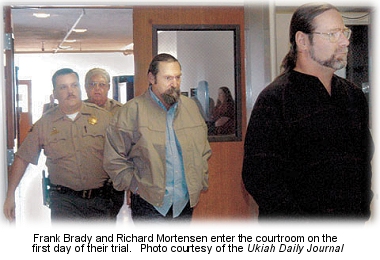 Wilburn C. Denton described what he saw on the day of the fatal collision. For about three hours, he said, he stood on the driveway in front of his house and watched airtankers flying over the blaze. "They cut around to the south and then come up behind us to make a full circle," he said, recalling the flight pattern over the fire. The Ukiah Daily Journal reported that Denton said he heard the sound of an engine that was much louder than the others. He spotted a tanker through the treetops, coming in at a very low angle and traveling in a different direction from the rest. "This guy peels up the middle of the valley," said Denton. "He's the first one who did that all day." And a moment later, the two planes collided. Asked by Mortensen's defense attorney, William Pinkus, whether the sky around the tankers was clear of smoke at the time of the collision, Denton said it was. Schoolteacher Pat Pollitt also testified for the defense and said that T-87 was following a different path than any of the other planes she saw. "He was coming from a very unusual pattern ... Very low, below the tree line ... Way lower than I had ever seen in my life nor had I ever seen a plane come up that ravine, ever," Pollitt said. Deputy District Attorney Keith Faulder asked Pollitt if she told NTSB investigators that all the tankers she saw that day were flying below the treetops. Pollitt said she had not. Faulder then read aloud from an NTSB transcript in which Pollitt was quoted as saying all the tankers were "near the treetops." Testimony from all three suggested that pilot error was responsible for the accident, but Judge Jeffrey Tauber ruled at the start of the trial that pilot error could not be used as a defense. GOVERNMENT SUES POWER COMPANY FOR WILDFIRE DAMAGESMARCH 05 -- SIOUX FALLS, SD: The federal government has sued a Rapid City power company for damages from a wildfire that threatened two towns, forced the evacuation of thousands of residents, and burned more than 10,000 acres last summer. A complaint filed Monday in U.S. District Court blames Black Hills Power & Light Co. for failing to trim trees that grew into a power transmission line, igniting the Grizzly Gulch Fire. "Black Hills Power did not keep their trees that were located in the right of way trimmed and they were able to come in contact with the electrical wire," said U.S. Attorney James McMahon. The federal lawsuit, according to the Aberdeen News, asks a jury to award damages for firefighting costs, reclaiming burned areas, and for the loss of timber and habitat. An exact figure of the federal government's loss has not been determined, but McMahon estimated it at more than $2 million. The lawsuit was filed on behalf of several agencies including the Forest Service, Bureau of Land Management, National Park Service, and Bureau of Indian Affairs. The Grizzly Gulch Fire started June 29 and burned nearly 17 square miles in the northern Black Hills by the time it was controlled on July 7. Of the more than 10,000 acres burned, 3,315 acres were on the Black Hills National Forest and 1,982 acres was BLM land. Last fall, the state of South Dakota sued Black Hills Power for damages from the same fire. Total costs of fighting the fire have been estimated at $5.4 million, with the state's share at about $1.1 million. 40-YEAR VOLUNTEER FIREFIGHTER HONORED IN SUBLIMITYMARCH 05 -- SUBLIMITY, OR: Herman Hendricks has lived in or around Sublimity for all his 67 years, volunteering in one capacity or another, and it was that volunteer spirit, according to the Statesman-Journal, that caught the attention of the Stayton-Sublimity Chamber of Commerce and prompted them to name him this year's Sublimity First Citizen. Hendricks was a volunteer firefighter with the Sublimity Volunteer Fire Department for more than 40 years. He was named firefighter of the year in both 1967 and 1981.
Jerry Heater, Sublimity's assistant fire chief, has worked with Hendricks for nearly 30 years. "Herman was always at the end of the hose line, ready to go in and attack anything," said Heater. "We were proud to have him at the firehouse for so many years." The firefighting tradition has continued in the Hendricks family; two of his six children work in fire. Kevin is a chief in Woodburn, and Karey is the captain at the Sublimity department. FIREFIGHTERS ON SHUTTLE PATROLMARCH 05 -- PALESTINE, TEXAS: Shuttle search operations are ongoing in Texas; the Bear Paw Hotshots trainee crew from Rocky Boy, Montana, is one of 30 crews dispatched from Montana, North Dakota, and Idaho to recover pieces of the space shuttle in east Texas. Firefighters have had to struggle through muddy swamps, heavy rains, and leg-scratching briars. "Everybody's doing great," Bear Paw crew boss Dan Friede Jr. told the Havre Daily News. "Everyone is happy to be here, happy to be helping out NASA." He said morale is good despite near constant rain and occasional sleet and snow. Besides the nasty weather, there's the terrain. "You could be in clear fields one day," said Friede, "and be in just the thickest brush you've ever been in the next." According to a CNN report, some searchers on the Sabine National Forest became ill after being exposed to chemical fumes. Three searchers were treated and released at a hospital after searching near a hole in the ground that was emitting a chemical smell. "We had two crews out in that area, and they had severe reactions that varied from headaches and nausea to vomiting," said Cynthia Sage with the U.S. Forest Service. Friede said his crew is finding debris from the shuttle every day but he could not confirm the type of materials they were finding. The crews in Palestine are finding materials that NASA says are significant, according to NASA spokeswoman Mary Hicks.
 As of yesterday, there were 34 crews in the field from the Palestine base, with 958 people in camp. They searched nearly 800 acres on Monday and recovered 56 pieces of material. As of yesterday, they'd completed searches on almost 18,000 acres and had recovered more than 4,500 items. They're are finding between 20 and 30 pieces of the shuttle each day, according to Gail Thurston, a dispatch coordinator at the Great Falls Interagency Dispatch Center. Six crews from Montana were dispatched to east Texas by the Great Falls Interagency Dispatch Center last week, Thurston said, including the Rocky Boy crew, a crew from Helena, two from the Forest Service near Great Falls, two from the Blackfeet Indian Reservation, and one from the Fort Belknap Indian Reservation. Crew members start work at 6 a.m. and are putting in 12- to 14-hour days. Dick Schwecke with the Forest Service said there have been no problems with insects or alligators as some had worried, but that briars with thick thorns are scratching the crew members' legs. "I don't think we've ever seen briars like we have down here," he said. "Their legs are paying the price." Crews also have had problems with ticks, and have seen wild boar tracks. When a piece from the shuttle is located, it must be categorized as one of four different types of material. The first type, general material, is collected in bags by the crews themselves, and accounts for most of what's found. The three other categories are material significant to the investigation (such as black boxes and large structural pieces), crew-related material, and hazardous materials such as stored energy and pyrotechnic devices. When search crews find these materials, instead of collecting them, they mark the materials and notify the EPA crews behind them. Search crew members are not allowed to photograph what they find, and there are penalties and fines for keeping any materials. "It feels good helping out NASA knowing what kind of loss they went through," said Friede. "We feel for them, and they're appreciative, and that feels good too." NEW FEDERAL LEGISLATION WOULD COVER WIDOWS OF FIRE PILOTSMARCH 04 -- WASHINGTON, DC: Since 1976, the federal Public Safety Officers' Benefits (PSOB) program has provided millions of dollars to families of firefighters and police officers killed or severely injured in the line of duty. Survivors currently receive about $260,000 in benefits, along with scholarships for the children of fallen officers. But PSOB doesn't extend to those who work on contract, and that's how fire pilots are hired. Despite their status as contractors, aerial firefighters take on an unusual level of risk, according to an MSNBC feature by Jon Bonné. Just last year, air crews accounted for a third of the 18 deaths from fighting wildfires. And despite numerous appeals to the Justice Department, which operates the program, no contract pilot's family has been considered eligible. The Justice Department did not respond to several requests for comment on Bonné's story. Fighting fires from the air is far from lucrative -- the average fire pilot might earn $35,000 to $45,000 during a six-month season. Fire agencies usually won't -- or can't -- hire full-time pilots. "It's cheaper for our government to contract pilots and aviation," says Vicki Minor, executive director of the Wildland Firefighter Foundation, which helps firefighters' families. "There has to be change in the system." Wanda Nagel, a 15-year veteran fire pilot, sums up the disparity succinctly. She and her husband Gary had already been writing to petition changes in the PSOB program when he died flying a fire in 1998. She sought benefits, but the Justice Department denied her request. But she still flies air attack for the state of California, which requires that she fly with a state-employed firefighter in the back of her OV-10 Bronco. "If I go down on a fire with a passenger," says Nagel, "he will be considered a firefighter, get PSOB, and I would not. And we're killed in the same aircraft." But change is in the works. Rep. Barbara Cubin of Wyoming introduced a bill last week that would extend benefits to fire pilots, even if they're contracted. To Cubin, benefits aren't just a way to ease the financial burden on survivors, they're also a matter of simple fairness.
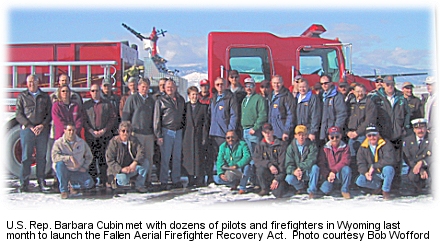 "Common sense tells us that these firefighters fight fires on public lands," Cubin says. "They protect America, and we ought to protect them." Cubin has drafted a bill, the Fallen Aerial Firefighter Recovery Act, that would amend the Federal Land Policy and Management Act of 1976 to provide death and disability benefits for aerial firefighters. H.R.977 was referred to the Committee on Resources and the Committees on Agriculture and the Judiciary. On the federal level, there's relatively little money at stake. Even if compensation for fire pilots were made retroactive to the PSOB's 1976 inception, Cubin estimates total payments to families would be about $18 million. But that's less than the $20 million Congress gave last year to the Institute for Software Research in West Virginia, and it's considerably less than the $460 million that was spent for one Amphibious Assault Ship. For most pilots' families, the money is less significant than an acknowledgement by the government that their loved ones were doing a valuable, important job. ENVIROS CATEGORICALLY REJECT CATEGORICAL EXCLUSIONSMARCH 04 -- ROSEBURG, OR: Bush administration efforts to streamline paperwork and limit lawsuits over low-impact tree harvests are getting a categorical rejection from southwest Oregon environmental groups. Exceptions to environmental rules, called "categorical exclusions," are allowed by the National Environmental Policy Act and have existed for many years. Two new exclusions have been recently proposed that would allow sanitation and salvage harvests of dead and dying trees on projects of up to 250 acres, and a third exclusion would allow 50-acre cuts of live trees for the construction of temporary roads, landings, and skid trails. Carol Cushing heads the North Umpqua Ranger District where the 17,600-acre Apple Fire last summer left thousands of acres blackened. The News-Review reported that in some areas complete stands of young trees were burned away. And Cushing says that up to 10 months and 200 pages of environmental work and documentation would be required before a project could begin. But under an existing categorical exclusion, she's been able to reduce the environmental review to one month and a six-page document. "Based on our wildfire experience in 2002," said Cushing, "managers need some different tools to help us solicit citizen participation while moving through our process a little quicker. There is a real need to treat hazardous fuels on the Umpqua National Forest." "I have just made a decision to reforest some stands in the Apple Fire area that aren't of commercial size," she explained. "We are not going to salvage log them. We can plant all the available stock we have next month." U.S. Forest Service Chief Dale Bosworth said the new rules will help the agency meet its mission to care for the land. "The agency hopes to reduce the bureaucratic red tape and save time, energy, and money in preparing small, routine, timber harvesting projects that are supported by local communities," he said. Francis Eatherington with the local environmental group Umpqua Watersheds said they supported a wildfire risk reduction project in the Little River area that was allowed under a categorical exclusion. The group also is in favor of rules that allow trails and facilities maintenance to occur without a fuss. But they object to the use of categorical exclusions to allow yew tree bark and bough collection in old-growth reserves. They also oppose the harvest of live trees or salvage without public review and the "leverage" over how those projects are conducted. Paula Trudeau, district planner for the Tiller Ranger District, said they don't expect to see categorical exclusions become a tool for more flexible forest management anytime soon. "This will likely end up in court," she said. "There are a lot of people in the United States who want their voice heard and they feel categorical exclusions cut them out." Mark Buckbee, associate manager for the BLM Roseburg District, said he was unable to comment on the effect of similar environmental policy changes proposed by the Department of the Interior. The BLM is considering a ban on appeals of fire suppression projects. GAG ORDER IN TEXASMARCH 01 -- CORSICANA, TEXAS: In the first few days after the space shuttle Columbia broke apart, NASA won praise for openly discussing the search for debris and possible causes of the accident. But information is harder to come by lately, according to an AP report in the Houston Chronicle, and some officials in the east Texas debris field say they have been told to stop talking to reporters. Marcus Beard, district ranger for the Sabine National Forest, said NASA officials at the command center in Lufkin have told people in the field not to say where searchers were looking or what they found. "We're not even supposed to show maps," said Beard.  "There's a lot of limitations to what we can say," said Chuck Dickson, a public affairs officer for the base camp in Palestine. He said the restrictions reflected NASA's sensitivity about recovery missions. Three Type 1 teams (Mike Lohrey, Kim Martin, and Scott Vail) are assigned in Corsicana, Hemphill, and Palestine. Custer's Type 2 team is assigned in Nacogdoches, and Hildreth's Type 2 team is setting up operations at the Longview staging area. Some team members have said that FEMA and NASA have issued what amounts to a gag order -- information officers are not allowed to give out information, and anything that is distributed has to be approved first. Some likened it to the 09/11 disaster in New York, when national team information officers were not allowed to fulfill their ICS functions because the incident command system was not used initially, and matters of national security (combined with NYPD's desire to retain control of information) outranked the usual procedures under ICS.
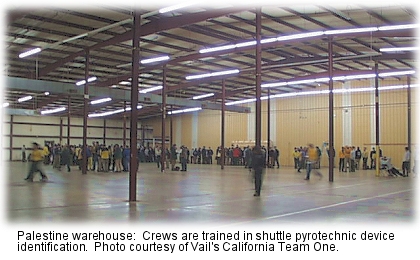 A NASA spokesman, Kelly Humphries, denied that local officials were ordered not to talk to reporters. "They don't want reporters getting out in the field and interfering with activities," said Humphries. In the first two weeks after the February 01 disaster that killed all seven astronauts aboard Columbia, most of the information about the search came from local sheriffs and emergency officials who helped coordinate the scouring of fields, forests and lakes. But county sheriffs began limiting their comments, and two weeks later state and federal officials relieved locals of their direct role in the search. Now the major official source of information is a command center in Lufkin. According to the AP report, though, officials there don't readily give out information on shuttle parts or answer specific questions. It took about a week before officials would confirm that a metal object recovered from the Toledo Bend Reservoir was part of the shuttle. The day after the nose landing gear was found near the lake last week, officials in Lufkin confirmed it, but only after a journalist got detailed information from a source with another federal agency. And that source has since begun referring calls to Lufkin.
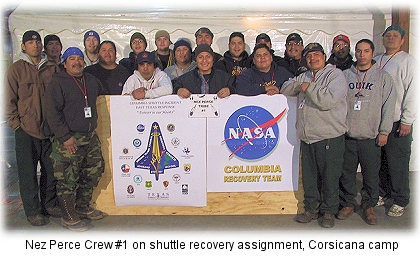 Officials from other federal agencies have declined to talk to reporters, some saying they feared losing their jobs. An EPA employee spoke reluctantly with a reporter Thursday about material found in the area, but he stopped when asked to spell his name. "I'm going to get in trouble," he said, asking the reporter to limit his comments. "If you'll keep it to 'The EPA's assisting the recovery efforts' ... I won't get in trouble over that." The day after NASA announced it had recovered a videotape showing four of the astronauts in the last minutes of the flight, the AP asked where the tape had been recovered. A FEMA spokesman in Lufkin said he had no information and referred calls to NASA. A NASA spokesman suggested calling FEMA. Hours later, the NASA spokesman, Bill Jeffs, called back to say that the tape had been found near Palestine on Feb. 6, but said he could not give further details. Open-government advocates said none of the information involving the search and recovery should be kept secret. "There's absolutely no reason to withhold this information, and if there is, no one's telling us what it is," said Wanda Cash, president of the Freedom of Information Foundation of Texas and editor and publisher of The Baytown Sun.
 "This is one of the most public disasters of the space program," said Donnis Baggett, chairman of the legislative advisory committee of the Texas Daily Newspaper Association and the Texas Press Association. "The whole nation and the world shared in the traumatic discovery that we had lost a shuttle. It seems only logical that the federal government would share with us the status of the recovery and the investigation on a daily basis." NASA may have its own plans for increasing the flow of information, but it doesn't involve the news media. Last week, as a reporter and photographer questioned NASA spokeswoman Kathy Barnstorff about media access, she said the space agency was considering bringing in its own photographers and TV crews to the Hemphill area. "Partly for your safety," she said, and partly to avoid media "interference." Incident team members have suggested to reporters that information will be available at columbiarecovery.com, (which is registered to Media Services Group, a PR agency that specializes in serving churches and ministries). The website says it is updated from the Lufkin Command Joint Information Center, but contains mostly agency logos and links with no current information. Lohrey's Pacific Northwest Team 2 site is shy on news, but does have a photo gallery of the crews assigned to their Corsicana ICP. Scott Vail's team has updates and photos. FOREST RESOURCES INSTITUTE EMPLOYS HIGH-TECH TOOLS IN SHUTTLE SEARCHFEBRUARY 28 -- NACOGDOCHES, TEXAS: When the shuttle Columbia began its fatal dive to Earth, the folks of Nacogdoches had no idea they would become the center of worldwide attention. Shuttle engine parts, reentry tiles, laptop computers, even a Columbia operating manual were among the materials that fell from the sky. Teams of volunteers and professionals swung into action, zigzagging across wide areas of east Texas farmland, forest, brush, and swamp in a hunt for Columbia wreckage. Initial reports of shuttle materials on the ground were mapped using approximated coordinates of reported Nacogdoches County locations. These points were then used to calculate a Base Search Vector. In Nacogdoches County, according to a report by space.com, 90 percent of mitigated shuttle material sites have been found within a two-kilometer buffer on either side of the Base Search Vector. A FEMA Emergency Operations Center has been established in Lufkin; three Type 1 teams (Lohrey, Martin, and McCombs) are assigned in Corsicana, Hemphill, and Palestine. Custer's Type 2 team is assigned in Nacogdoches, and Hildreth's Type 2 team is setting up operations at the Longview staging area. There are 35 agencies and a total of 5,405 personnel helping with the search for and collection of shuttle materials. The ongoing search for materials has been aided by not just firefighters on the ground but also a bevy of high-tech tools, from high-altitude aircraft scans to low-flying powered parachute vehicles, along with remote sensing and Global Positioning System satellites. "Columbia literally landed in our laps and we were on top of it within minutes," said Paul Blackwell, an information scientist for the Forest Resources Institute, which is affiliated with the Arthur Temple College of Forestry at the Stephen F. Austin State University in Nacogdoches. Blackwell said the institute produced a variety of map products to help searchers. The maps products required extensive use of remote sensing satellite technology -- France's SPOT, NASA's Landsat 7, Digital Globe's QuickBird, and Space Imaging's Ikonos spacecraft -- coupled to geographical information system software tools. "We moved that imagery out into the field, into the hands of those searching to help them navigate," Blackwell said. The Forest Resources Institute focuses on forest health and management issues, but researchers have also been working on hazard mitigation efforts. They've considered floods, an industrial accident, or hurricanes. "What we never thought about was a space shuttle coming down on top of us," said Blackwell. "That wasn't in the plan." There is a new toll-free FEMA hotline to report shuttle material locations: (866)446-6603. Typical shuttle debris pictures are online at www.nasa.gov/columbia/COL_debris_pix.html HELM GETS COMMUNITY SERVICEFEBRUARY 27 -- RIFLE, CO: An Oregon woman who was driving a van that crashed and killed five fellow firefighters pleaded guilty Wednesday to one careless driving charge and was sentenced to 50 hours of community service. Megan Helm, 21, of La Grande, Oregon, also was ordered to pay $317 in fines and court costs, according to an Associated Press report. Helm originally faced 10 misdemeanor charges of careless driving causing death or injury. She and ten other fire crew members from Grayback Forestry were en route to the Hayman Fire in Colorado last June when the van rolled on Interstate 70 near Parachute. Four people were killed, and a fifth died three days later. Five others were injured. Criticism initially directed at Helm has shifted to the 15-passenger Ford Ecoline E-350 Super Duty van she was driving. The National Highway Traffic Safety Administration has reported that rollover rates of stretch vans manufactured by Ford, Chevrolet, GMC and Dodge are three times those of regular vans when carrying 10 or more passengers. Families of at least three dead firefighters and two of the injured firefighters filed lawsuits against Ford Motor Company. FIRE BILL CUTS FUNDS FOR RESEARCH AND FOREST RESTORATIONFEBRUARY 27 -- MISSOULA, MT: The U.S. Forest Service will not be reimbursed for nearly $300 million of the $1.2 billion the agency spent fighting wildfires last summer, leaving some forest restoration and research programs without full funding. The Missoulian reported today that another billion-dollar fire season would mean even more work could be unfunded. The federal government's just-signed fiscal year 2003 appropriations bill reimbursed the Forest Service for $636 million of the $919 million "borrowed" from national forests and research labs nationwide to pay last summer's suppression costs. The season last year was so expensive that the Forest Service's $275 million firefighting budget was depleted by the end of June. When Congress refused to approve emergency supplemental funding, the Forest Service froze all non-fire budgets and raided them for fire funds. The Region 1 forests of Montana and northern Idaho lost about $80 million, including $25 million intended for restoration and replanting of forests burned two summers earlier on the Bitterroot National Forest. "We've had the authority to transfer funds to pay for wildfire suppression for a long, long time," said regional budget director Mike Paterni. "But this is the first time we've had to use it, at least in my memory." In the past, Congress has either approved emergency midseason funds for firefighting or has quickly restored any raided accounts at the end of the year. This time, congressional leaders warned the Forest Service not to expect 100 percent reimbursement. "This really makes it difficult to be a prudent manager - if you're always trying to second-guess what's going to happen and modifying your program based on how you read the tea leaves," said Kevin Ryan, fire effects project leader at the Fire Sciences Lab in Missoula. "It makes it extremely difficult to make good, sound decisions and to see those decisions through." The Bitterroot National Forest took a sizable hit because it had $25 million in National Fire Plan money in the bank when the call came for help, according to deputy forest supervisor Spike Thompson. That money was intended for the rehabilitation of forests burned during the 2000 wildfire season. "We are still hopeful that we will get enough funds restored that we'll be on schedule with this year's work," said Thompson. "We are really committed to this work, but we've always known it would take three to five years, and probably 10 years for the reforestation." The work on the Bitterroot includes watershed rehabilitation, road repair, and reforestation work on the 300,000 acres burned during the summer of 2000. Less than 2 percent of the watershed work included in the forest's burned area recovery plan has been completed. On the Black Hills National Forest, funding cuts will affect timber thinning, weed control, erosion control, construction and maintenance of roads and trails. "It's going to hurt," said Dave Thom, a natural- resources staff officer. The Rapid City Journal reported that last fall, Forest Supervisor John Twiss said he would ask for an additional $7 million for restoration projects, including $1.6 million for the Battle Creek Fire area and $4.1 million for the ongoing rehab of the Jasper Fire area west of Custer. Twiss eventually trimmed the request to $5 million, but the new budget will provide just $800,000. SAN BERNARDINO EYES FIRESTORM POSSIBILITYFEBRUARY 25 -- SAN BERNARDINO, CA: It may be an inferno that's hotter, faster, and more dangerous than anything most firefighters have seen. Thousands of dead and dying trees spread across the San Bernardino Mountains stand like giant gasoline cans awaiting a spark, and all that dry timber has fire officials discussing strategy. "We've never been experienced with this amount of dead vegetation," Capt. Lyle Drenth with CDF told the San Bernardino County Sun. More than 150,000 acres on the San Bernardino National Forest have experienced major tree die-offs, due to a four-year drought and an infestation of bark beetles. "If a crown fire started running," said Drenth, "it wouldn't matter if you had one fire engine or one hundred, because you can't get in front of it. If we burn an engine or get people hurt, we won't be effective." Officials compare the situation to fireplace fuels. Logs in a fireplace require a lot of heat before they ignite, because of the moisture inside the wood. Right now, the dead trees on the San Bernardino would burn like open newspaper tossed into the flames, flaring up hot and fast. Firefighters saw similar behavior at wildfires last summer; CDF Assistant Chief Tim Sappok said flamelengths were 25 to 50 percent more than normal. "It's off the scale of what we've seen before," said Sappok. "We could make some saves in places if we recognize what's going on. If we attack it the way we're used to, we're going to lose people." In Lake Arrowhead, Crestline, and other mountain communities, homes are nestled among thick stands of dead trees. Firefighters, who normally would focus on saving property, may have to turn their attention to the forest. "We may have to let one house go to save a hundred," said Chief Bill Bagnell of the Crest Forest Fire Protection District. "That'll be hard for firefighters." Drenth said any home on the side of a slope or at the top of a ridge may be indefensible. Under normal circumstances, firefighters would aggressively try to save homes in those locations, but a fire in current conditions would be moving too fast and burning too hot to risk firefighters' lives. During a recent tour of areas around Lake Arrowhead hardest hit by the drought and bark beetles, county Fire Marshal Peter Brierty pointed to narrow, steep, tree-choked roads. "If you're a battalion chief, do you send your people down there?" asked Brierty. CDF crews are felling dead trees alongside main roads to help ensure a safe evacuation and create wider firebreaks; the Forest Service is cutting a 600-foot shaded firebreak along the north part of Lake Arrowhead. MARINE CORPS BILLED $10 MILLION FOR FIRE WHERE WASS, LEBARE, AND DAVIS CRASHEDFEBRUARY 22 -- CARSON CITY, NV: The U.S. Marine Corps has been asked to pay $10 million to cover suppression costs on the 22,750-acre Cannon Fire near Yosemite that took the lives of three aerial firefighters last June. The fire was ignited in an area where Marine mountain warfare trainees had set dozens of practice campfires, but the Forest Service's report on its cause hasn't been released. The Marines haven't released details of their report on the blaze, either, according to an Associated Press report, and the U.S. Department of Justice is reviewing the Forest Service's report. The Forest Service confirmed Wednesday that the cost estimate of the fire, which burned along the California-Nevada state line, went to the Marines, who run a mountain warfare training base in the area. First Lt. Daniel Rawson said the Marine Corps was working to resolve the issue in a timely and equitable manner, and negotiators are focused on interagency agreements between the Marines and the Forest Service. The USMC Mountain Warfare Training Center was established in 1951 as a Cold Weather Battalion to provide cold weather training for replacement personnel bound for Korea. MCMWTC is located on California Highway 108 at Pickel Meadow, 21 miles northwest of Bridgeport, California and 100 miles south of Reno, Nevada. The center occupies 46,000 acres of Toiyabe National Forest, and an agreement between the Forest Service and the Marine Corps permits the use of the area to train Marines in mountain and cold weather operations. The Forest Service says the agreements require the Department of Defense to pay it for any costs directly attributable to military training in the area -- subject to available funds. Four days after the fire began, a C-130A airtanker assigned to the fire crashed near Walker, California, killing all three crew members on board: pilot Steven Wass, 42, of Gardnerville, Nevada; co-pilot Craig Labare, 36, of Loomis, California; and crew member Michael Davis, 59, of Bakersfield, California. ARIZONA'S FIRST WILDFIRE ACADEMY SCHEDULED IN MARCHFEBRUARY 22 -- PRESCOTT, AZ: Summit Fire Chief Don Howard wants to make sure Arizona firefighters are prepared for what could be another devastating wildfire season. In response to a demand for better training for rural firefighters, Howard has helped create Arizona's first Wildfire Academy, scheduled for March 11-16 in Prescott. The academy, according to the Arizona Daily Sun, will kick off March 10 with a "forest health summit." After last year's unprecedented wildfire season and the ongoing drought conditions, Howard said his department's biggest concern is a major wildland fire breaking out near communities in Coconino County.
More than 400 applications to attend the academy already have been received from Arizona firefighters and as far away as Maine and New Jersey. Howard will serve as the incident commander at the academy. Chief Jim Pond, at Highlands Fire Department in Kachina Village, will serve as Howard's deputy incident commander. "If we have a productive spring with precipitation, we'll be in a lot better shape around here," said Pond. "But if not, it could be another record-setting year. It's really getting kinda old." Clyde Benally, AFMO for the Peaks District on the Coconino National Forest, said the county will be sending people to the academy. The concept for an Arizona Wildfire Academy began in 1994, when Colorado created its own academy. Colorado began with 90 participants and now has more than 1,700. Texas and Utah also have academies. Howard said the Arizona State Fire Training Committee has been crucial in starting the process toward Arizona's wildfire academy. The committee began in 1974 after an explosion fire in Kingman killed 14 people, many of whom were volunteer firefighters. Participants at the academy will be able to chose from 18 different courses, from Basic Firefighting and Wildfire Behavior to Fire Operations in the Urban Interface. For more information on the academy, contact Kori Kirkpatrick ([email protected]), P.O. Box 2554, Prescott, Arizona 86302 or Chief Don Howard ([email protected]), Summit Fire District, 8905 N. Koch Field Road, Flagstaff, Arizona 86004 (928)526-9537. OREGON UNINSURABLE?FEBRUARY 22 -- GRANTS PASS, OR: The Oregon Department of Forestry is scrambling to convince insurance underwriters that the state is still worth taking a risk on after last summer's intense wildfire season. According to an Associated Press report, a call for bids to duplicate last summer's policy from Lloyd's of London, which saved the state $22.5 million, has generated no responses. Acting State Forester Roy Woo said the state should have heard by now. He said that state firefighting budget cuts, a level federal firefighting budget, and the potential for another dry summer could make the 2003 fire season "a Perfect Storm." The state's insurance broker says Oregon faces higher premiums, a higher deductible, and some kind of "co-pay" if it hopes to get a policy. "It's in the hands of the Legislature to craft a funding package for fighting fire in this state that allows you to attract an insurance package," said Jim Brown, chief environmental adviser to Gov. Ted Kulongoski. The state has previously purchased insurance to cover spikes in firefighting costs -- since the 1987 season, when ODF spent $30 million and forced the emergency allocation of about $15 million in general funds. Last year Oregon paid $3.5 million for a $43 million policy that paid out $25 million of the $59.5 that ODF incurred in suppression costs. Private timberland owners paid $10 million up front, and the rest was covered by a variety of other state and federal sources. But this year the failure of the Measure 28 income tax increase forced a cut of $681,474 -- nearly 12 percent -- in the ODF fire budget. Woo said he is working with the Forest Service and BLM to change some federal firefighting rules, such as allowing more flexibility in shift schedules for firefighters and increasing firefighting efforts on the ground when risk is highest. BARTON GETS SIX YEARS IN PRISONFEBRUARY 22 -- DENVER, CO: A former U.S. Forest Service employee tearfully apologized yesterday to Coloradans before being sentenced to six years in prison for starting the largest wildfire in state history. "I'd like to say that I'm sorry and I have not forgiven myself yet," said Terry Lynn Barton. "By my emotional act I have destroyed something that I loved." The Associated Press reported that Barton pleaded guilty to both federal arson charges and a state arson charge. She will be sentenced in March on the state charge, which could warrant another 12 years in prison. The 138,000-acre Hayman Fire destroyed more than 130 homes 55 miles southwest of Denver and caused an estimated $13 million in damage. U.S. District Judge Richard Matsch rejected the government's request that Barton be ordered to pay $14.7 million to cover suppression costs and restoration on the Pike National Forest. "I'm not going to sentence Ms. Barton to a life in poverty," he said. "But she must suffer the consequences of this action that she herself described as a stupid thing and unthinking thing." The Colorado Springs Gazette reported that the prosecution will be asking for millions of dollars in restitution. "In Colorado, the law requires restitution, and we expect the judge will order that as well," said Jeanne Smith, 4th Judicial District Attorney. Matsch did not require Barton to pay restitution on the federal charge because he believed she made a mistake that had horrible consequences. He said a letter-writing campaign from Barton's friends, family, and co-workers asking for leniency influenced him. Barton initially told investigators that she smelled smoke and discovered the fire while patrolling on the forest. Later, she said she accidentally started the fire while burning a letter from her estranged husband. Investigators believe she started the fire deliberately. FIREFIGHTERS AND TEAMS IN TEXAS FOR SHUTTLE RECOVERYFEBRUARY 20 -- FORT WORTH, TEXAS: One hundred Indian firefighters from eastern Montana flew to Texas yesterday to help with the search for materials from the space shuttle Columbia. The crews will spend up to a month scouring the forests, fields, and swamps along the Texas-Louisiana border. The Billings Gazette reported that crews will work 12-hour days, walking grid patterns searching for any speck of the fallen shuttle. The call for crews was issued Friday by federal officials. Within an hour, most of the orders were filled. "It's a chance to help the country," said Mario Pretty Boy, a crew boss from Lame Deer. "It's kind of cool being a part of history," said Weaver Beartusk of Lame Deer. The eastern Montana task force is part of 600 firefighters from Montana and northern Idaho being sent to Texas this week, according to Colleen Finneman at the Interagency Northern Rockies Coordination Center in Missoula. Thirty-five helicopters, together with 3,500 searchers on the ground, are searching for Columbia's remnants along a 240-mile-long path that runs from just south of Dallas to the Toledo Bend Reservoir. The material fell from the shuttle as it was re-entering Earth's atmosphere along a line stretching generally from San Francisco to Lafayette, Louisiana, according to NASA. No confirmed materials have been found west of Fort Worth, but NASA is urging people to search 60 miles north or south of the re-entry track, particularly in the following counties: in Arizona -- Apache, Navajo, Coconino, Mohave; in Nevada -- Lincoln; in New Mexico -- San Juan, Kane, Beaver; and in Utah -- Washington, Iron, San Juan, Garfield. Crews are searching for pieces of reinforced carbon that could be parts of the shuttle's wing. Pieces of the wing could be west of Texas because the wing broke up first; those who find possible shuttle material should not touch it because of hazards from fuel residue. Found materials should be reported to investigators at 1-866-446-6603. Soldiers and law enforcement officers were among the first organized teams of wreckage searchers after the shuttle disintegrated February 1 high above Texas. "They were using National Guard crews," said Finneman. "But they got pulled back to deal with military issues at hand." Wildland firefighters from a variety of federal agencies have been asked by the Office of Homeland Security to help with the search effort. Forest Service Information Officer Gay Ippolito said there are 28 20-person incident management teams at the base camp in Nacogdoches County. She said when camps in Hemphill, Nacogdoches, and Palestine reach full strength, they will have 34 teams each, including about 100 U.S. Forest Service personnel from the Sierra, Sequoia, and Stanislaus National Forests, 300 from South Dakota, and 100 from Montana. Search crews are working 13-hour days trying to navigate almost impenetrable areas of the Piney Woods, according to the Nacogdoches Daily Sentinel. Several searchers who have been through the woods of east Texas describe the briar-choked forests with an almost reverent air of intimidation. But Richard Tingle, superintendent of the Santa Fe Hotshots, shrugs it off. "It's just flack," he said. "This is not hard work." The call-up is the first major test of the Office of Homeland Security, according Ken Arney, an official with the Southern Region of the U.S. Forest Service. "A manned space station is still orbiting," said Arney. "We shouldn't need any more motivation to get this job done." Nature is adding to the time pressure; the wreckage will be obscured by leaves and green grass within a month. KTRE-TV reports that the search will be even harder as spring approaches. "This tree is starting to flower out," said John Boyette with the Texas Forest Service. "Within just a few weeks, were going to have just an explosion of color and green, and that's going to make it much more difficult to get through the work. All the vegetative growth, the leaves, the flowers, are going to obscure your view of the woods and of the ground. If there's something out there that we're trying to find, it's going to be much more difficult to find that, it's going to be hidden behind the wall of green." Ippolito said several dozen ground crews were either in training or busily searching areas near base camps in Hemphill and Nacogdoches. The Lufkin Daily News reported that another 34 crews will begin searching near Palestine on Friday, and at NASA's request, a fourth base camp was opened in Corsicana. Ippolito said she couldn't confirm rumors that ground crews would soon number 4,000-strong, but said that recovery efforts were definitely being stepped up. David Passey, a FEMA spokesman, said 450 additional members were added to ground crews on Wednesday, bringing the total number of state and federal personnel involved in the actual ground search to more than 1,800. Passey said that even as hundreds of debris sites were being cleared, the search for additional sites would continue Although the mission is unusual, the firefighters are experienced in search work, according to Mike LeBrun, acting FMO in the Billings office of the Bureau of Indian Affairs. After wildfires are controlled, firefighters spend days or weeks canvassing burned acres searching for lingering embers. "Our people have been trained to systematically cover an area by gridding," he said. "They're used to working as a crew and covering large areas." Motels in east Texas are already filled with searchers, so the incoming firefighters will be living in fire camps for up to 30 days. Hazards, according to a Forest Service briefing sheet, include lyme disease-bearing ticks, venomous snakes, and alligators. Luckily, the cool weather keeps alligators sluggish this time of year, but the firefighters are warned, "Watch where you put your hands." FALLEN AERIAL FIREFIGHTER RECOVERY ACT LAUNCHED IN BUFFALOFEBRUARY 17 -- BUFFALO, WY: Under clear blue skies with the snow-capped Big Horn Mountains in the background, several dozen firefighters lined up next to two engines to greet U.S. Rep. Barbara Cubin on Saturday morning at the Johnson County Airport in Buffalo. She thanked each of them for what they do to protect lives and property and resources, and they thanked her for what she's doing for aerial firefighters. "This is just a national disgrace," said Cubin. "These pilots are protecting our wildlands, our resources, and, in many cases, our lives. They put their lives on the line for us every day they fly. We need to return the favor and remember to look out for them." The Casper Star-Tribune noted that Cubin said it's just unbelievable that pilots' families are not covered if something catastrophic happens.
Cubin has drafted a bill, the Fallen Aerial Firefighter Recovery Act, that would extend federal death and disability benefits to the families of aerial firefighters; she was in Buffalo on Saturday to officially launch the bill and meet with pilots, widows of pilots, airtanker operators, firefighters, and the media. "We wouldn't think of sending our armed troops to war without providing for them," said Cubin. "It's just unthinkable that we would ask aerial firefighters to put their lives on the line for us and not provide for them and their families."
"She firmly believes that this is a wrong that needs to be righted," said Wofford. "She hopes to make the bill retroactive for all the aerial firefighters killed in the line of duty." Brent Conner, also on the board of the AAP, explained that the cost of life insurance for a tanker pilot is beyond the reach of most pilots -- it's simply not affordable. "Unfortunately for our families," he said, "this does not stop us from flying; we love our jobs." Conner explained that his father was killed in a tanker accident in 1979. "Though he's been gone for over 22 years, I still think of him every day. My mother did not have to worry about losing her home, and I cannot imagine the agony of a family dealing with that in addition to the death of a loved one. There is little we can do about the loss, but maybe we can help with some financial security."
Duane Powers, co-owner of Hawkins & Powers Aviation, and Dana Peirson, another of Neptune's pilots, discussed the need for PSOB for aerial firefighters, and expressed their gratitude to Cubin for what she's doing. Chris Holm, another Neptune pilot and also on the AAP board, explained that he was a groundpounder before he was a tanker pilot. He recalled how his crew got into a tight spot on a fire some years ago; he said it took many years and a bit of research before he got to shake the hand of the pilot -- Carl Dolbeare -- who saved his life. Connie Hirth, who in 1997 lost her husband John and their best friend William Babka in the crash of a PV2 tanker, spoke about the emotional and financial devastation wreaked upon the families when pilots are killed. She and other widows present -- including Christine Groff and Wanda Nagel -- thanked Cubin for her efforts on behalf of them and others. Hirth, who owns Hirth Air Tankers in Buffalo, is the Family Benefits Chair for the AAP and has worked tirelessly on behalf of the survivors of fire pilots and crew killed in action. Wardall and Shep Shepherd with the Honor Guard arranged for Hirth to pin the Honor Guard memorial flag with two black ribbons bearing the names of John Hirth and William Babka. "Those ribbons and those names will remain on that flag as long as this Honor Guard is in existence," said Shepherd. "But I hope to never see the name of another airtanker pilot on that flag." Six members of the Honor Guard presented the "Ringing of the Last Alarm" in honor of fallen firefighters. Their bagpipe-and-drum corps played "Amazing Grace," and presented a truly professional and moving tribute to fallen aerial firefighters. "The CDF Firefighters Honor Guard did an outstanding job," said Wofford later. "It really put the right touch on things. Also, Connie Hirth, all the local firefighters, the mayor, and the Buffalo Wild Bunch from the Chamber of Commerce did a great job making us all feel welcome." A hearty lunch was provided for everyone by the Johnson County and Kaycee Fire Departments at Fire Station #1 in Buffalo.
A huge thank-you to Connie Hirth, Dave Wardall, the Honor Guard, Mike Gilmore and Pacific Jet Charter, and everyone else who worked so hard to make this historic day such a success. FEDERAL DEATH BENEFITS FOR FIRE PILOTS PROPOSED BY WYOMING CONGRESSWOMANFEBRUARY 14 -- WASHINGTON, DC: U.S. Representative Barbara Cubin (R-WY) announced this week that she will introduce a bill to extend federal death and disability benefits to the families of aerial firefighters. Cubin will be in Buffalo, Wyoming, tomorrow for a press conference to launch her proposed legislation. "During last year's fire season, six airtanker pilots and crew members lost their lives while fighting wildfires," said Cubin. "Unfortunately, current law does not allow the federal government to recognize their sacrifice by extending death benefits to their families. This is an oversight we must bring to an end, and I am introducing a bill in Congress to do just that."
Cubin's bill will make tanker pilots and crew killed in the line of duty eligible to receive benefits under the federal government's Public Safety Officers' Benefits (PSOB) program. Current federal regulations exclude the families of privately employed aerial firefighters, even though government agencies contract with these private companies for firefighting services. "Their families deserve to have this peace of mind," said Cubin. "Aerial firefighters serve the public good in every possible sense, and their courage ought to be recognized." The PSOB program, administered by the federal Department of Justice, provides a one-time lump sum payment of roughly $260,000 to surviving family members of individuals classified as public safety officers. Airtanker pilots and crew, however, are not considered public safety officers because they work for private companies that contract with the government. "While it's true that the pilots are flying for private contractors, they are flying over public land, and they're protecting the lives and property of citizens," said Cubin. "These pilots are protecting our wildlands, our resources, and, in many cases, our lives. We ought to return the favor and remember to look out for them." The press conference in Buffalo [MAP] on Saturday will be open to the public and will include remarks by Rep. Cubin and representatives from the aerial firefighting industry. Tanker pilots, firefighters, members of the Associated Airtanker Pilots, and aircraft including Neptune's T-11 will also be on hand. Pacific Jet Charter has provided a Super King Air 350 to fly the CDF Firefighters Honor Guard to Wyoming, along with a representative of the AAP benevolent fund and two widows of fire pilots killed in action. For more information on Saturday's press conference, contact Joe Milczewski ([email protected]) in Washington, D.C., at (202)225-2311. More information on PSOB is available online.
NEED A 2003 FIRE CALENDAR?JANUARY 25 -- AGNESS, OR: If you need a fire calendar for someone (yourself, perhaps?) you can't do much better than this for ten bucks. It's the coolest fire calendar we've ever seen.
The calendar is 12 x 9 inches folded, and it opens to 12 x 18 inches. It's 28 pages long, with 13 full-color images. The Biscuit Fire burned nearly 500,000 acres in southwestern Oregon and northern California, and it threatened a number of communities, including the Agness-Illahe area. These calendars are available for only $10 each, and proceeds benefit the Volunteer Fire Department in Agness. For a limited time, order five calendars and get a sixth one free. Shipping is included, and there's no sales tax in Oregon. Get yours now at www.biscuitcalendar.com before they're gone |

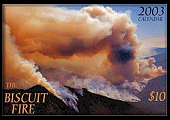





 The U.S. intelligence community believes that terrorists will attempt multiple attacks against U.S. and other targets in the event of a military campaign against Saddam Hussein. The DHS and other federal departments have activated increased protective measures under a national plan called "Operation Liberty Shield." It includes measures to increase border security, strengthen transportation protections, enhance infrastructure security, increase public health preparedness, and ensure that all federal response assets can be quickly deployed.
The U.S. intelligence community believes that terrorists will attempt multiple attacks against U.S. and other targets in the event of a military campaign against Saddam Hussein. The DHS and other federal departments have activated increased protective measures under a national plan called "Operation Liberty Shield." It includes measures to increase border security, strengthen transportation protections, enhance infrastructure security, increase public health preparedness, and ensure that all federal response assets can be quickly deployed.
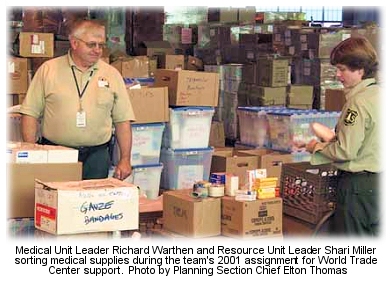 The Severe Condition (Red) reflects a severe risk of terrorist attacks. Protective measures for a red condition are not intended to be sustained for long. In red status, federal agencies would increase or redirect personnel to address critical emergency needs, assign emergency response personnel and pre-position and mobilize specially trained teams or resources, monitor or redirect or constrain transportation systems, or close public and government facilities.
The Severe Condition (Red) reflects a severe risk of terrorist attacks. Protective measures for a red condition are not intended to be sustained for long. In red status, federal agencies would increase or redirect personnel to address critical emergency needs, assign emergency response personnel and pre-position and mobilize specially trained teams or resources, monitor or redirect or constrain transportation systems, or close public and government facilities.
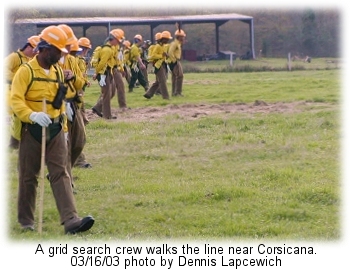 State expenses eligible for reimbursement include search and recovery costs, emergency medical care, security in the affected area, and activation of emergency operations centers. FEMA, a formerly independent agency now a part of the Department of Homeland Security, is in charge of the recovery effort. Since mid-February, more than 3,000 workers per day have searched 103,000 acres, collecting 22,100 pieces of material. As of March 6 the search was using 32 helicopters and nine fixed-wing aircraft; seven boats and underwater sonar units were searching lakes and reservoirs.
State expenses eligible for reimbursement include search and recovery costs, emergency medical care, security in the affected area, and activation of emergency operations centers. FEMA, a formerly independent agency now a part of the Department of Homeland Security, is in charge of the recovery effort. Since mid-February, more than 3,000 workers per day have searched 103,000 acres, collecting 22,100 pieces of material. As of March 6 the search was using 32 helicopters and nine fixed-wing aircraft; seven boats and underwater sonar units were searching lakes and reservoirs.
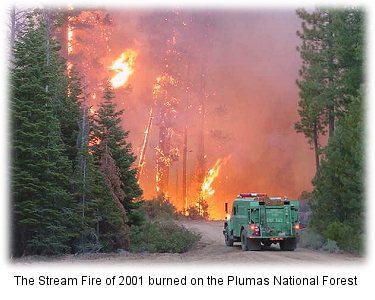 A report by the
A report by the 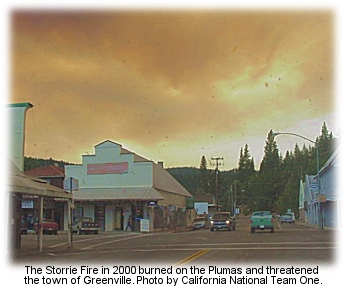
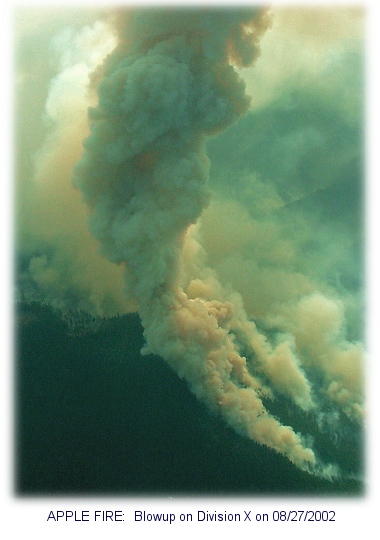 The Forest Service originally considered about 2,500 acres for logging operations. More than half the acreage was removed from consideration, however, after biologists nixed riparian zones and areas with fragile soils. The plan for the "Baked Apple" sale will be submitted to the Federal Register within the next few days, beginning a series of public meetings, release of a draft environmental impact statement, a period for public comment, and printing of a final plan. Harvests are not likely to begin before next year.
The Forest Service originally considered about 2,500 acres for logging operations. More than half the acreage was removed from consideration, however, after biologists nixed riparian zones and areas with fragile soils. The plan for the "Baked Apple" sale will be submitted to the Federal Register within the next few days, beginning a series of public meetings, release of a draft environmental impact statement, a period for public comment, and printing of a final plan. Harvests are not likely to begin before next year.
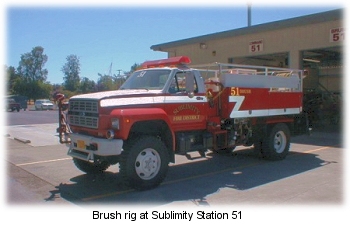 Sublimity Fire District consists of 35 volunteers who respond out of two fire stations -- Station #51 (Headquarters) and Station #52 northeast of the city of Sublimity, about 15 miles east of Salem.
Sublimity Fire District consists of 35 volunteers who respond out of two fire stations -- Station #51 (Headquarters) and Station #52 northeast of the city of Sublimity, about 15 miles east of Salem.
 "We live in the middle of the largest contiguous ponderosa pine forest on Earth," Howard said.
"We live in the middle of the largest contiguous ponderosa pine forest on Earth," Howard said.
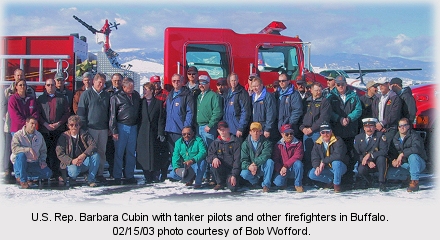
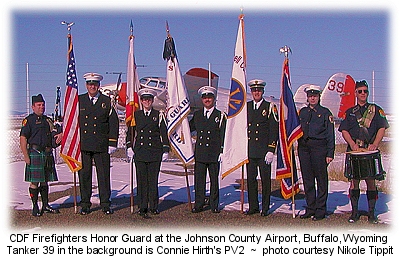
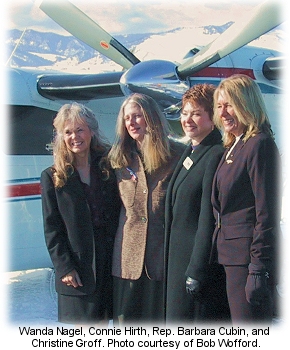 "Extending Public Safety Officers' Benefits to the families of tanker pilots and crews is the right thing to do."
"Extending Public Safety Officers' Benefits to the families of tanker pilots and crews is the right thing to do."
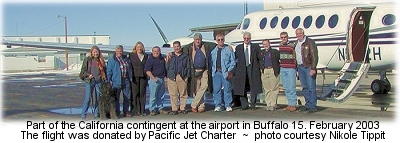 Dave Wardall is Deputy Chief for CDF in charge of aircraft maintenance and engineering. Wardall did a fine job of arranging for the trip to Buffalo by the CDF Firefighters Honor Guard. The flight from Sacramento, in a King Air 350 turboprop equipped with an AirShow 400 (which projects trip information overlaid on actual maps displayed on video monitors in the cabin), was generously donated by
Dave Wardall is Deputy Chief for CDF in charge of aircraft maintenance and engineering. Wardall did a fine job of arranging for the trip to Buffalo by the CDF Firefighters Honor Guard. The flight from Sacramento, in a King Air 350 turboprop equipped with an AirShow 400 (which projects trip information overlaid on actual maps displayed on video monitors in the cabin), was generously donated by  "These pilots and flight crews are basically on the front lines when it comes to fighting wildfires," added
"These pilots and flight crews are basically on the front lines when it comes to fighting wildfires," added 